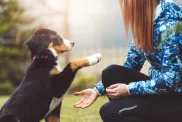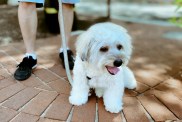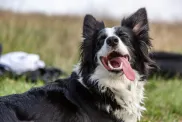The Beagle, a member of the hound group, holds a special place in the hearts of many due to its intelligence and friendly nature. With their soulful eyes and wagging tails, Beagles have become one of the most loved dog breeds. Originally bred for hunting small game such as rabbits, They instinctively desire to track scents. This can lead them astray if they catch a scent during outdoor walks, so owners should ensure their dogs are on a leash to prevent them from wandering too far.
One of the defining traits of the Beagle is their mischievous nature appeal. They have a curious and playful streak, and their sense of adventure often leads them into escapades that can get them into trouble. Beagles are social animals and thrive on companionship. When left alone for extended periods, they may become bored and resort to mischief to entertain themselves. Thus, it’s crucial for their human parents to provide them with adequate mental and physical stimulation and avoid leaving them alone for too long.
Training is essential for Beagles, and their intelligence makes them quick learners. However, they can also be independent thinkers and may have a stubborn streak, especially if they catch an intriguing scent during training sessions. Positive reinforcement, especially in the form of tasty treats, works wonders.
This breed’s friendly and affectionate nature extends to other animals. Beagles make good companions for other dogs and cats, especially if they are raised together from an early age. Early socialization and positive experiences with other animals can further enhance their amiable disposition.
Quick Facts
- Origin: England
- Size: 13-15 inches tall at the shoulder, 20-30 pounds
- Lifespan: Beagles live to 10-15 years
- Temperament: Friendly, gentle, playful, curious
- Grooming needs: Low; requires weekly brushing
- Health concerns: Hip dysplasia, elbow dysplasia, eye problems, allergies
- They were originally bred to hunt small game, such as rabbits and foxes.
- This breed is known for their baying, which is a high-pitched howl that they make when they are excited or following a scent.
- The iconic cartoon character Snoopy is a Beagle
- Former President Lyndon B. Johnson had four Beagles
Related: Beagle Puppies: Cute Pictures & Facts
Beagle Dog Pictures
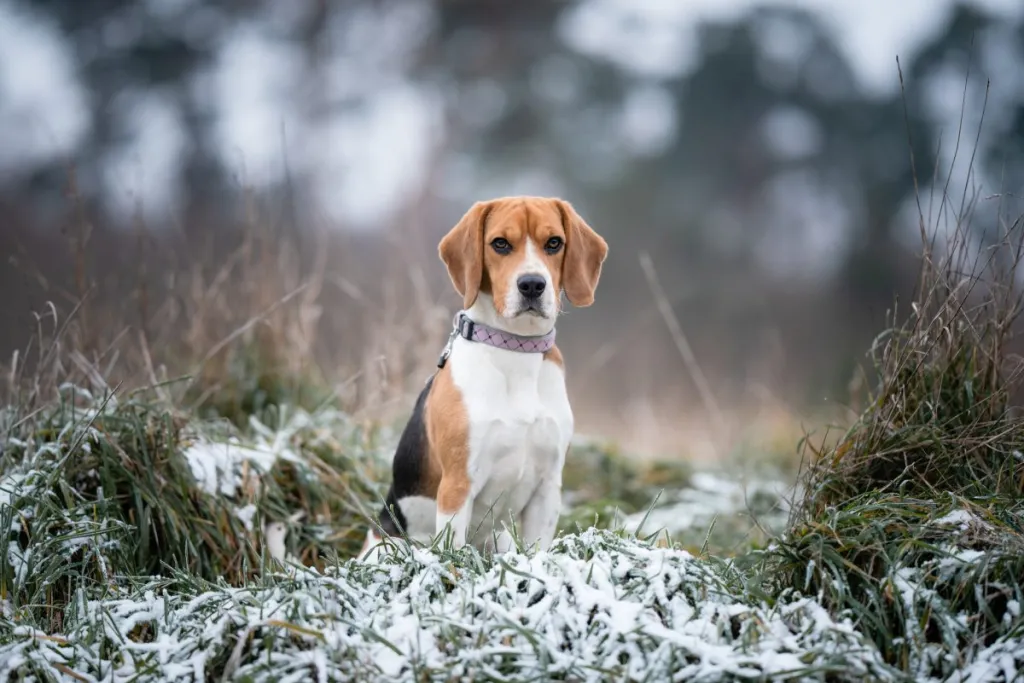
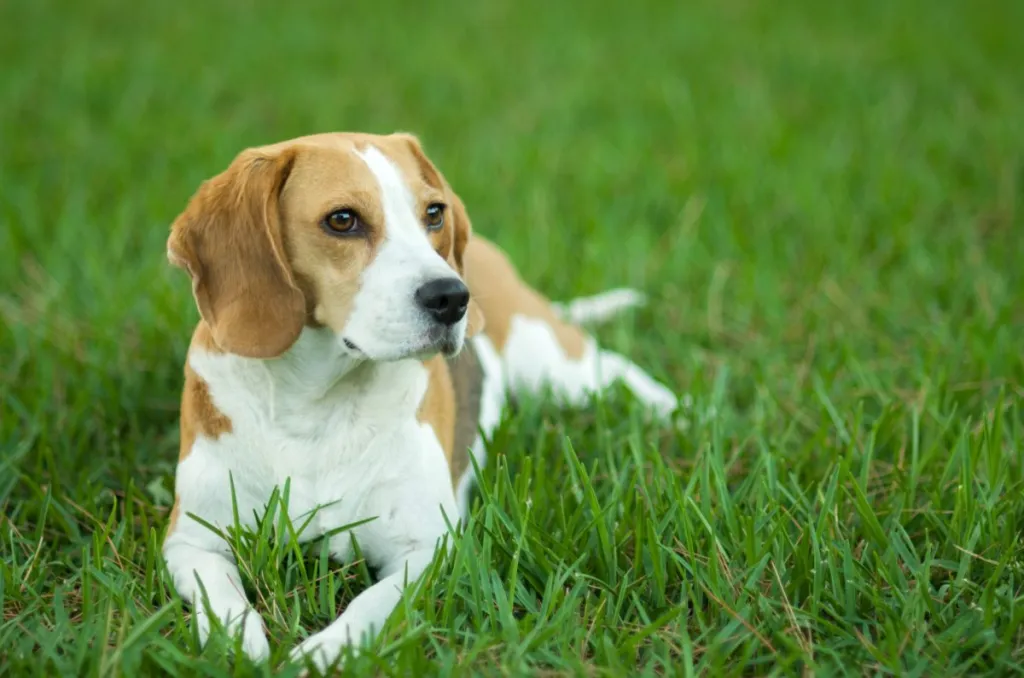



Adaptability
-
Adapts Well To Apartment Living
Looking for the best dog for your apartment? Contrary to popular belief, the suitability of dogs who adapt well to apartment living goes beyond its size. Apartment dwellers have a myriad of dog breeds to choose from as potential companions, with various factors to consider. Some large breeds can adapt well to apartment living and have lower activity levels. Others may require more space and possess higher energy levels. On the other hand, certain small dog breeds with abundant energy can still find contentment with indoor playtime or brisk walks.
However, when selecting a dog that adapts well apartments, it is essential to prioritize your neighbors. Opting for a pet that doesn’t excessively bark and behaves politely when encountering others in shared spaces like is crucial for maintaining a harmonious apartment environment.
In high-rise settings, it’s worth noting that numerous small dogs may exhibit a propensity for high energy and frequent barking. This makes them less suitable for apartment living. Therefore, desirable qualities in an apartment dog encompass being quiet, low-energy, and displaying polite behavior towards other residents.
Factors To Consider When Choosing A Dog For An Apartment
When considering dogs that adapt well to apartments, size alone should not be the sole determinant. Apartment dwellers have a wealth of dog breeds to choose from as potential furry companions. It’s important to remember that the size of your living space is just one factor to consider. While some larger breeds can adapt well to apartment living, with lower, others may require more space and have higher energy levels, making them less suitable for smaller apartments. Conversely, certain small dog breeds with higher energy levels can still thrive in apartments, finding contentment through indoor playtime or brisk walks. However, it is crucial to consider your neighbors’ comfort when selecting a dog. Opt for a pet that doesn’t bark excessively and behaves politely when interacting with others in shared spaces.
Therefore, it’s important to prioritize qualities such as being quiet, low-energy, calm indoors, and exhibiting good manners when living in close proximity to other residents. By considering these factors, you can find a dog that will adapt well to apartment living and create a harmonious living environment for everyone involved.
-
Good For Novice Owners
Some dogs are simply easier than others; they take to training better and are fairly easygoing. They’re also resilient enough to bounce back from your mistakes or inconsistencies.
Dogs who are highly sensitive, independent thinking, or assertive may be harder for a first-time dog parent to manage. You’ll get your best match if you take your dog-owning experience into account as you choose your new pooch.
If you’re new to dog parenting, take a look at 101 Dog Tricks and read up on how to train your dog!
-
Sensitivity Level
Some dogs will let a stern reprimand roll off their backs, while others take even a dirty look to heart. Low-sensitivity dogs, also called “easygoing,” “tolerant,” “resilient,” and even “thick-skinned,” can better handle a noisy, chaotic household, a louder or more assertive owner, and an inconsistent or variable routine. Do you have young kids, throw lots of dinner parties, play in a garage band, or lead a hectic life? Go with a low-sensitivity dog.
-
Tolerates Being Alone
Some breeds bond very closely with their family and are more prone to worry or even panic when left alone by their owner. An anxious dog can be very destructive–barking, whining, chewing, and otherwise causing mayhem. These breeds do best when a family member is home during the day or if you can take the dog to work.
-
Tolerates Cold Weather
Breeds with very short coats and little or no undercoat or body fat, such as Greyhounds, are vulnerable to the cold. Dogs with a low cold tolerance need to live inside in cool climates and should have a jacket or sweater for chilly walks. You can find a great jacket for your dog here!
-
Tolerates Hot Weather
Dogs with thick, double coats are more vulnerable to overheating. So are breeds with short noses, like Bulldogs or Pugs, since they can’t pant as well to cool themselves off. If you want a heat-sensitive breed, your dog will need to stay indoors with you on warm or humid days, and you’ll need to be extra cautious about exercising your dog in the heat.
All-around friendliness
-
Affectionate With Family
When it comes to unconditional love and unwavering loyalty, few animals can rival the affectionate nature of dogs. These remarkable creatures have earned their reputation as man’s best friend, and many breeds are particularly renowned for their love and devotion to their families. With their warm hearts and wagging tails, affectionate family dogs enrich the lives of their owners in countless ways.
One such breed known for its affectionate demeanor is the Golden Retriever. With their gentle temperament and friendly disposition, Golden Retrievers form deep bonds with their families. They eagerly participate in family activities, whether it’s a game of fetch in the yard or cuddling on the couch during a movie night. Their expressive eyes and ever-wagging tails are a testament to the joy they feel in the presence of their loved ones.
Another family-favorite breed is the Labrador Retriever. Renowned for their playful and patient nature, Labradors are excellent companions for children and adults alike. They readily engage in playtime with the kids, showcasing their boundless energy and enthusiasm. But when the day winds down, they seamlessly transition into loving and gentle cuddle buddies, comforting their family members with their warm presence.
Beyond specific breeds, mixed-breed dogs also have a special place in the hearts of families seeking affectionate companions. The shelter dogs, in particular, form deep connections with their adoptive families. They seem to understand the second chance they’ve been given and repay it with endless love and gratitude.
How To Know If A Dog Is Good With Families
The affectionate nature of family dogs extends beyond play and cuddles. Dogs have a remarkable ability to sense their owner’s emotions, offering comfort and support during difficult times. Whether it’s a wagging tail after a long day at work or a sympathetic nuzzle during moments of sadness, they prove time and again that they are attuned to their family’s needs.
It is important to note that not all dogs of the same breed will be equally affectionate. Some dogs may be more independent or aloof, while others may be more clingy or demanding of attention. The best way to find out how affectionate a dog is is to meet them in person and interact with them.
-
Kid-Friendly
Being gentle with children, sturdy enough to handle the heavy-handed pets and hugs they can dish out, and having a blasé attitude toward running, screaming children are all traits that make a kid-friendly dog. You may be surprised by who’s on that list: Fierce-looking Boxers are considered good with children, as are American Staffordshire Terriers (which are considered Pit Bulls). Small, delicate, and potentially snappy dogs such as Chihuahuas aren’t always so family-friendly.
**All dogs are individuals. Our ratings are generalizations, and they’re not a guarantee of how any breed or individual dog will behave. Dogs from any breed can be good with children based on their past experiences, training on how to get along with kids, and personality. No matter what the breed or breed type, all dogs have strong jaws, sharp pointy teeth, and may bite in stressful circumstances. Young children and dogs of any breed should always be supervised by an adult and never left alone together, period.
-
Dog Friendly
Friendliness toward dogs and friendliness toward humans are two completely different things. Some dogs may attack or try to dominate other dogs, even if they’re love-bugs with people; others would rather play than fight; and some will turn tail and run. Breed isn’t the only factor. Dogs who lived with their littermates and mother until at least six to eight weeks of age and who spent lots of time playing with other dogs during puppyhood, are more likely to have good canine social skills.
-
Friendly Toward Strangers
Stranger-friendly dogs will greet guests with wagging tails and nuzzles; others are shy, indifferent, or even aggressive. However, no matter what the breed, a dog who was socialized and exposed to lots of different types, ages, sizes, and shapes of people as a puppy will respond better to strangers as an adult. Remember that even friendly dogs should stay on a good, strong leash like this one in public!
Health And Grooming Needs
-
Amount Of Shedding
If you’re going to share your home with a dog, you’ll need to deal with some level of dog hair on your clothes and in your house. However, shedding does vary greatly among the breeds. Some dogs shed year-round, some “blow” seasonally, some do both, and some shed hardly at all. If you’re a neatnik, you’ll need to either pick a low-shedding breed or relax your standards. To help keep your home a little cleaner, you can find a great de-shedding tool here!
-
Drooling Potential
Drool-prone dogs may drape ropes of slobber on your arm and leave big, wet spots on your clothes when they come over to say hello. If you’ve got a laid-back attitude toward slobber, fine; but if you’re a neatnik, you may want to choose a dog who rates low in the drool department.
-
Easy To Groom
Some breeds are brush-and-go dogs; others require regular bathing, clipping, and other grooming just to stay clean and healthy. Consider whether you have the time and patience for a dog who needs a lot of grooming, or the money to pay someone else to do it.
-
General Health
Due to poor breeding practices, some breeds are prone to certain genetic health problems, such as hip dysplasia. This doesn’t mean that every dog of that breed will develop those diseases; it just means that they’re at an increased risk.
If you’re adopting a puppy, it’s a good idea to find out which genetic illnesses are common to the breed you’re interested in. You may also want to ask if your shelter or rescue has information about the physical health of your potential pup’s parents and other relatives.
-
Potential For Weight Gain
Some breeds have hearty appetites and tend to put on weight easily. As in humans, being overweight can cause health problems in dogs. If you pick a breed that’s prone to packing on pounds, you’ll need to limit treats, make sure they get enough exercise, and measure out their daily food servings into regular meals rather than leaving food out all the time.
Ask your vet about your dog’s diet and what they recommend for feeding your pooch to keep them at a healthy weight. Weight gain can lead to other health issues or worsen problems like arthritis.
-
Size
Get ready to meet the giants of the doggy world! Large dog breeds aren’t just big balls of fluff, they’re like loving, oversized teddy bears on a mission to steal your heart. Need some convincing? Let’s dive into the awesome benefits of owning one!
First things first, these pooches are a living security system! With their impressive size and thunderous barks, they’ll have any would-be intruder running for the hills. Talk about peace of mind! Plus, who needs an alarm when you’ve got a furry giant protecting your castle?
But that’s not all. Large dog breeds are all about loyalty and devotion. They’ll stick by your side through thick and thin, becoming your most dedicated bestie. Their love knows no bounds! When you have a giant fluffball showing you unconditional love, you’ll feel like the luckiest human on the planet.
Now, let’s talk about their talents. These big fellas are the ultimate working partners. With brains and brawn, they’re up for any challenge. From search and rescue missions to lending a helping paw to those in need, these dogs are superheroes in fur coats. They’ll make you proud every step of the way!
Don’t let their size fool you—these gentle giants have hearts as big as their paws. They’re incredible with kids and other pets, spreading their love like confetti. Their patience and kindness make them perfect family pets, ensuring harmony in your household.
Oh, and get ready to break a sweat! These dogs are fitness enthusiasts, and they’ll keep you on your toes. Daily walks, jogs, and play sessions will not only keep them happy and healthy but will also give you a reason to ditch the couch and join in on the fun. It’s a win-win situation!
So, if you’re ready for a dose of big love, go ahead and consider a large dog breed. They’re the best wing-dog you could ever ask for, ready to make your life a thousand times more exciting, loving, and downright awesome! Get ready for the big adventure of a lifetime!
Trainability
-
Easy To Train
Easy-to-train dogs are more adept at forming an association between a prompt (such as the word “sit”), an action (sitting), and a consequence (getting a treat) very quickly. Other dogs need more time, patience, and repetition during training.
Many breeds are intelligent but approach training with a “What’s in it for me?” attitude, in which case you’ll need to use rewards and games to teach them to want to comply with your requests.
Related:
10 Fun, Impressive Tricks You Can Teach Any Dog
-
Intelligence
Dogs who were bred for jobs that require decision making, intelligence, and concentration, such as herding livestock, need to exercise their brains, just as dogs who were bred to run all day need to exercise their bodies. If they don’t get the mental stimulation they need, they’ll make their own work–usually with projects you won’t like, such as digging and chewing. Obedience training and interactive dog toys are good ways to give a dog a brain workout, as are dog sports and careers, such as agility and search and rescue.
-
Potential For Mouthiness
Common in most breeds during puppyhood and in Retriever breeds at all ages, mouthiness means a tendency to nip, chew, and play-bite (a soft, fairly painless bite that doesn’t puncture the skin). Mouthy dogs are more likely to use their mouths to hold or “herd” their human family members, and they need training to learn that it’s fine to gnaw on chew toys, but not on people. Mouthy breeds tend to really enjoy a game of fetch, as well as a good chew on a toy that’s been stuffed with kibble and treats.
-
Prey Drive
Dogs with a high prey drive have an instinctive desire to stalk, capture, and prey upon potential food sources. Dogs who were bred to hunt, such as Terriers, have an inborn desire to chase — and sometimes kill — other animals. Anything whizzing by — such as cats, squirrels, and perhaps even cars — can trigger that instinct.
How to address a high prey drive
Off-leash adventures are too great a temptation for pups who will wander and hunt. Dogs who like to chase need to be leashed. And, even on a leash, you may experience your dog pulling on the leash to reach rodents or birds in their sight. Otherwise, these pups should be kept in a fenced area when outdoors. If your pup has a high prey drive, you’ll need a high, secure fence in your yard.
These breeds generally aren’t a good fit for homes with smaller pets that can look like prey, such as cats, hamsters, or small dogs. Breeds that were originally used for bird hunting, on the other hand, generally won’t chase, but you’ll probably have a hard time getting their attention when there are birds flying by.
Other behavioral concerns
Observing your dog’s prey drive, which is instinctual and biologically-rooted, is not the same as observing aggression. Much aggression is born of fear and anxiety, especially in the case of dog aggression toward humans.
The tendency to wander, even into oncoming traffic, can produce diasterious results for pups with predatory instincts. It can also lead to pups being bitten by snakes or attacked by other wild animals they may pursue while on the hunt.
-
Tendency To Bark Or Howl
Some breeds sound off more often than others. When choosing a breed, think about how often the dog vocalizes. Learn more about breeds with a tendency to bark or howl.
If you’re considering a hound, would you find their trademark howls musical or maddening? If you’re considering a watchdog, will a city full of suspicious “strangers” put your pup on permanent alert? Will the local wildlife literally drive your dog wild? Do you live in housing with noise restrictions? Do you have neighbors nearby? Then you may wish to choose a quieter dog.
-
Wanderlust Potential
Some breeds are more free-spirited than others. Nordic dogs such as Siberian Huskies were bred to range long distances, and given the chance, they’ll take off after anything that catches their interest. And many hounds simply must follow their noses–or that bunny that just ran across the path–even if it means leaving you behind.
Exercise needs
-
Energy Level
High-energy dogs are always ready and waiting for action. Originally bred to perform a canine job of some sort, such as retrieving game for hunters or herding livestock, they have the stamina to put in a full workday. They need a significant amount of exercise and mental stimulation, and they’re more likely to spend time jumping, playing, and investigating any new sights and smells.
Low-energy dogs are the canine equivalent of a couch potato, content to doze the day away. When picking a breed, consider your own activity level and lifestyle, and think about whether you’ll find a frisky, energetic dog invigorating or annoying.
-
Intensity
A vigorous dog may or may not have high energy, but everything they do, they do with vigor: they strain on the leash (until you train them not to), try to plow through obstacles, and even eats and drinks with great big gulps. These dynamos need lots of training to learn good manners, and may not be the best fit for a home with young kids or someone who’s elderly or frail. A low-vigor dog, on the other hand, has a more subdued approach to life.
-
Exercise Needs
Some breeds do fine with a slow evening stroll around the block. Others need daily, vigorous exercise, especially those that were originally bred for physically demanding jobs, like herding or hunting.
Without enough exercise, these breeds may put on weight and vent their pent-up energy in ways you don’t like, such as barking, chewing, and digging. Breeds that need a lot of exercise are good for outdoorsy, active people, or those interested in training their dog to compete in a high-energy dog sport, such as agility.
-
Potential For Playfulness
Some dogs are perpetual puppies — always begging for a game — while others are more serious and sedate. Although a playful pup sounds endearing, consider how many games of fetch or tag you want to play each day, and whether you have kids or other dogs who can stand in as playmates for the dog.
Beagle Overview
It’s hard to resist the appeal of a Beagle’s dark brown or hazel eyes, accompanied by their soft, pleading expression. They exude happiness, outgoingness, and love, traits balanced by their hound nature, which makes them inquisitive, determined, and highly food-focused. While not yappy, they possess three distinct vocalizations—a bark/growl, a baying howl, and a half-baying howl, often used when they spot prey or decide it’s time to wake the neighborhood at 6 a.m. As pack dogs, Beagles generally get along well with other animals and eagerly embrace new human friends.
The most significant characteristic of the Beagle is their scenthound nature. Their nose takes precedence, always close to the ground, in constant search of intriguing trails to follow. With approximately 220 million scent receptors compared to our paltry 5 million or so, Beagles possess an exceptional ability to detect scents. Dave Barry humorously referred to his in-laws’ Beagle as “a nose with feet.” This incredible sense of smell has even led to their use at airports, where Beagles patrol baggage-claim areas to sniff out contraband food. Their small, friendly, and cute demeanor puts people at ease, allowing them to focus on specific food articles while disregarding non-contraband items.
Despite their versatility, Beagles remain exceptional hunters of small game. AKC-sanctioned field trials at the National Beagle Club’s Institute Farm and similar activities in many other countries put breeders with packs to the test. These trials showcase the Beagle’s superb hunting skills.
The Beagle’s adaptability makes them suitable for apartment living, provided they receive regular on-leash walks several times a day, regardless of the weather. They thrive with about an hour of exercise daily, and without adequate exercise and attention, they can exhibit destructive behaviors if left alone for extended periods.
Beagle Highlights
Beagles may prove challenging to housetrain, and it could take up to a year for some to become fully housetrained. To facilitate the process, crate training is highly recommended.
When left alone for extended periods in a house or backyard, Beagles tend to get bored and may resort to howling, digging, or trying to escape, seeking ways to amuse themselves.
Excessive baying is the primary reason Beagles end up in rescue groups, as owners or neighbors grow tired of the noise. Proper training to control barking and howling is crucial.
Beagles are at risk of theft, particularly for use in research laboratories. Always supervise them outdoors and consider microchipping for added security.
Being scenthounds, Beagles may wander off if they catch an intriguing scent, as their noses dominate their senses.
While they are loving and gentle, Beagles can display independence and stubbornness. Obedience training, preferably using food as a reward, is recommended.
Beagles have a hearty appetite and can overeat if given the chance. Monitoring food intake, keeping cupboards closed, and securing trash cans is essential to prevent overeating.
Teach children to respect Beagles while they eat and avoid teasing them with food.
Due to their friendly nature, Beagles are not suited as protection or guard dogs. They tend to be amiable with everyone they meet.
Beagle History
The origin of the word “beagle” remains uncertain. Some theories suggest it could have derived from the French word “begueule,” meaning open throat, or the Old English word “beag,” meaning small. Others propose it may have come from the French word “beugler,” meaning to bellow, or the German word “begele,” meaning to scold.
The breed’s history is also shrouded in ambiguity, as the concept of modern breeds didn’t fully develop until the 19th century. Ancient Greek documents from 400 B.C. mention Beagle-like dogs, and it is believed that the Romans brought small rabbit-hunting hounds to England and crossed them with local hounds. These small hounds, possibly the ancestors of Beagles and Foxhounds, were introduced by William the Conqueror during the Norman Conquest in 1066.
Beagles gained popularity early in English history. During the reigns of Edward II and Henry VII, tiny Glove Beagles were in vogue, said to be small enough to fit in a gloved hand. Singing Beagles were also named for their melodious voices. Elizabeth I kept packs of Pocket Beagles, standing only 9 inches tall, depicted in paintings as short-legged and pointy-nosed. However, they fell out of favor due to their lack of speed.
In the 1700s, the Foxhound took precedence over the Beagle in England, as fox hunting became the favored sport. The breed would have declined further if not for farmers in England, Ireland, and Wales, who kept Beagle packs for hunting hare and rabbits, preventing their extinction.
In the mid-1800s, Reverend Phillip Honeywood established a Beagle pack in Essex, England, believed to be the ancestors of modern Beagles. Reverend Honeywood focused on hunting skills, not appearance. Concurrently, American breeders imported Beagles from England to improve their own dogs’ looks. They bred them smaller for rabbit hunting, leading to strains like the “Patch” Beagle, known for its large tri-colored spot and speed.
The American Kennel Club and the first Beagle specialty club were founded in 1884. In the same year, the AKC started registering Beagles. In 1916, members of the National Beagle Club purchased land in Virginia to hold field trials, which is now the site of many activities for the National Beagle Club.
Beagle Size
The American Kennel Club acknowledges two Beagle varieties based on height. The 13-inch variety is reserved for hounds not surpassing 13 inches in shoulder height, while the 15-inch variety is for hounds standing between 13 and 15 inches at the shoulder. Depending on their height, Beagles weigh anywhere from 18 to 30 pounds.
Beagle Personality
Beagles exhibit a gentle, sweet, and humorous nature that can bring plenty of laughter. However, their mischievous behavior may sometimes lead to moments of frustration. Beagle owners often find themselves attempting to outsmart their clever companions and resorting to food rewards to encourage temporary obedience. Just like any dog, early socialization is crucial for Beagles. Exposing them to diverse people, sights, sounds, and experiences during their youth helps ensure they grow into well-rounded and balanced adults.
Beagle Health
Not all Beagles will develop every listed disease, but it’s essential to be aware of these conditions if you are considering this breed.
Intervertebral Disk Disease: The spinal cord is surrounded by the vertebral column, and between the bones are intervertebral discs that act as shock absorbers. Intervertebral disk disease occurs when the inner jelly-like layer of a disc protrudes into the spinal canal and compresses the spinal cord, potentially causing pain, paralysis, and loss of bowel or bladder control. Treatment options include confinement and, in severe cases, surgery.
- Hip Dysplasia: An inherited condition where the thighbone doesn’t fit snugly into the hip joint, leading to pain and lameness. X-ray screening is the most certain way to diagnose hip dysplasia, and affected dogs should not be bred.
- Cherry Eye: A condition where the gland under the third eyelid protrudes and needs removal.
- Glaucoma: An eye disease that causes abnormally high eye pressure, leading to vision loss and blindness. It can be hereditary or secondary to other factors.
- Progressive Retinal Atrophy (PRA): A degenerative eye disorder causing blindness due to the loss of photoreceptors at the back of the eye.
- Distichiasis: Extra eyelashes grow on the oil gland in the eye, causing irritation and squinting. Surgical removal is required.
- Epilepsy: A neurological condition leading to seizures, which can be managed with proper diagnosis and treatment.
- Hypothyroidism: A disorder of the thyroid gland treatable with medication and diet.
- Beagle Dwarfism: A condition resulting in smaller size, possibly with other physical abnormalities.
- Chinese Beagle Syndrome (CBS): Characterized by a wide skull and slanted eyes, often accompanied by heart problems and toe abnormalities.
- Patellar Luxation: The patella is misaligned, causing lameness and potential arthritis. Severity can vary, and surgery may be needed for severe cases.
When purchasing a Beagle puppy, ensure the breeder provides health clearances for both parents, including tests for hip dysplasia, elbow dysplasia, hypothyroidism, von Willebrand’s disease, thrombopathia, and normal eyes certified by the Canine Eye Registry Foundation (CERF). Preparing for potential veterinary needs throughout your dog’s life is wise, and a pet insurance plan can help you stay ready.
Beagle Care
A fenced backyard is essential for a scenthound like the Beagle. When outdoors, it’s important to keep your Beagle on a leash in open areas or securely confined and supervised. Beagles have a natural tendency to wander, so it’s common for them to try to escape. To ensure a swift return if they do get out, make sure your Beagle is microchipped and wears identification tags on their collar. Some people opt for underground electronic fences, but these may not deter other animals from entering your yard, and a tempting scent can lead your Beagle to disregard the momentary shock.
Obedience training is beneficial for all dogs, and Beagles respond best to positive reinforcement techniques. They may switch off and become unresponsive when treated harshly. Most Beagles are highly motivated by treats, making them eager to learn and obey commands.
Adolescent Beagles are full of energy and require ample opportunities to release it. They enjoy going for walks with their family or engaging in a good run across a field to satisfy their hunting instincts (though proper recall training is crucial before off-leash activities). You can also take them jogging, but it’s best to wait until they are at least 18 months old for repetitive exercises like this.
As Beagles mature, they might become more sedentary and content to lounge around the house all day. However, it’s crucial to prevent them from becoming lazy and overweight, as they are prone to obesity. Regular exercise and a balanced diet are essential to keep your Beagle healthy and happy.
Beagle Feeding
The recommended daily amount for Beagles is 3/4 to 1.5 cups of high-quality dry food, divided into two meals. However, the actual quantity your adult dog needs depends on various factors such as size, age, build, metabolism, and activity level. Just like people, dogs are individuals, and their food requirements vary. Active dogs will need more food than sedentary ones. The quality of the dog food also matters; better-quality food provides more nourishment, so you may need to feed your dog less.
Beagles have a reputation for being food thieves and can easily raid your pantry or garbage if given the chance. They have voracious appetites and will eat until they are full. To maintain a healthy weight, measure your Beagle’s food and feed them twice a day instead of leaving food out all the time. If you’re unsure about their weight, you can perform the eye test and the hands-on test. Look down at your Beagle – you should see a waistline. Place your hands on their back with your thumbs along the spine and fingers spread downward – you should be able to feel, but not see, their ribs without pressing hard. If you cannot feel the ribs easily, your dog may need less food and more exercise. Treats should also be given sparingly; small training treats work just as well as larger biscuits.
Beagle Coat Color And Grooming
According to the breed standard, Beagles can come in “any hound color.” However, the most common color for Beagles is tricolor, featuring a black saddle across the back, white legs, chest, and belly, a white tip on the tail, and tan markings on the head and around the saddle. Another popular color combination is red and white, displaying an Irish spotting pattern on the face, neck, legs, and tail tip. Regardless of color, most Beagles have a white tip on their tails to make them visible while hunting in tall grass.
Beagles have a smooth, dense double coat that resists rain. To maintain their coat’s health, it’s recommended to brush them at least once a week using a medium-bristle brush or a hound glove. This helps loosen and remove dead hair and promotes new hair growth. While Beagles do shed, their short hair makes it less noticeable. Their coat may become thicker during winter, leading to more shedding in the spring. Beagles are generally clean dogs but may occasionally indulge in rolling in something unpleasant. As they are drop-eared dogs, their ears need special attention to avoid infections. Regularly check their ears for signs of infection or waxy buildup and never allow water or oils to enter their ears.
Proper dental care is crucial for Beagles. Brush their teeth at least two or three times a week to prevent tartar buildup and maintain good oral hygiene. Daily brushing is even better to ward off gum disease and bad breath. Regular nail trimming is essential to prevent painful tears and other issues. If you’re not experienced with nail trimming, seek guidance from a vet or groomer.
Introduce grooming and examinations to your Beagle from an early age. Handle their paws frequently to get them used to the sensation and inspect their mouth regularly. Positive experiences during grooming with praise and rewards will make veterinary exams and other handling easier in adulthood. While grooming, also check for any sores, rashes, or signs of infection on their skin, nose, mouth, and eyes, as well as their feet. Conducting a careful weekly exam will help you identify potential health problems early on.
Beagle Children And Other Pets
Beagles form strong bonds with everyone in the family, particularly with children. However, due to their playful nature, they can sometimes be exuberant during playtime. Proper socialization and supervision are essential, especially when interacting with very young children. Beagles may exhibit “mouthy” behavior, playfully grabbing objects, including hands, with their mouths. While this is usually done in fun, they can be trained not to do so. As with any dog breed, it’s important to teach children how to approach and interact with dogs, and to always supervise their interactions.
Children should be educated never to disturb a dog while it’s eating or sleeping, and they should avoid attempting to take the dog’s food away. Under no circumstances should a dog, no matter how friendly, be left alone with a child without adult supervision. Beagles have a pack dog heritage, making them sociable animals that thrive on companionship. They dislike being left alone for extended periods. To fulfill their need for companionship, having another dog or even a cat as a playmate can be beneficial for their well-being.
Beagle Rescue Groups
Beagles are often acquired without any clear understanding of what goes into owning one. The following rescue groups can help you find Beagles in need of adoption or fostering.

